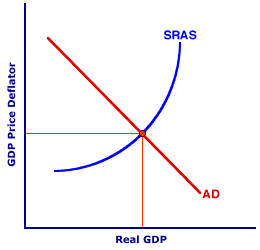AD measures levels of production which won't change over time as a function of price
AS measures levels of production which suppliers will actually produce at as a function of price.
SO... what happens when you put both of them together?

Answer: You get a real level of output which doesn't change over time (at the intersection point). Here, GDP is at an equilibrium, which means that output is equal to expenditures. Also GDP is an actual achievable level of output, which firms are willing to produce at, given the price level, to maximize profits: The actual output is in equilibrium!
The general price level is the y-axis, and we can use it to determine inflation (increases in the general price level)
GDP is the x-axis, and we can use actual GDP in relation to potential GDP to determine unemployment
This is also a stable equilibrium! If the price level is too low, then aggregate demand will overwhelm what producers are actually willing to produce. As production increases to meet the needs of the consumers, however, the accompanying rise in the price level reduces consumer demand until the two meet in the middle. Whenever the economy is not at macroeconomic equilibrium, there are pressures which ultimately bring it back to a state of equilibrium
Aggregate Demand Shocks and Macroeconomic Equilibrium:

These are a bit more tricky. If a change in autonomous expenditure shifts the family of aggregate expenditure functions, then in turn the Aggregate Demand function will shift (to the left in expenditure is lower, and to the right if it is higher). However, in macroeconomic equilibrium, an increase in aggregate demand predicts an accompanying increase in prices, while lower aggregate demand predicts an accompanying drop in prices (remember, firms will only produce more if prices increase to stabilize profit margins). This change in the price level changes aggregate expenditure, causing it to shift up or down due to a new price!
As a general rule, both price and output move in the same direction as a demand shock (increased demand = more output at higher prices. Decreased = less output at lower prices)
You may have noticed, but the simple multiplier, due to the change in price, can no longer predict the change in output caused by changes in expenditure. Instead, we use the multiplier (not simple, just multiplier) to determine output changes which result from expenditure changes. The multiplier is smaller than the simple multiplier. It represents the change in GDP divided by the change in aggregate expenditure.
The severity of a demand shock depends on the state of the economy: in other words, where an economy lies on the Aggregate Supply Curve.

When the economy has excess capacity (constant costs of production), it is called Keynesian short run aggregate supply (this is the flat part of the AS curve). Increases in AE cause Y to rise and Price to remain the same.
When the economy has increasing costs (the middle of this graph where the AS curve is about diagonally sloped), this is intermediate short run aggregate supply. Here, increases in aggregate expenditure cause increases in both price and output.
When the economy has rapidly increasing costs, this is classical short run supply (the vertical part of the AS curve). Here, increases in aggregate expenditure lead to increases in price, and no change in output.
Basically, the steeper AS is, the more a demand shock will affect price, and the less it will affect output.
We can have supply shocks too! The new intersection point is the new stable macroeconomic equilibrium.

Be careful- in some cases, both AS and AD will shift in response to a single event! (for an example, let's say the price level in China rises. This increases domestic AD (because of increased net exports). However, if domestic producers buy a lot of intermediate products from China, then their costs of production just rose, so aggregate supply shifts to the left. The net effect could be either positive or negative: it depends how invest producers are in chinese intermediate goods, and how much of the domestic economy is trade-determined.
Okay- that's all you'll need for the test. Good luck!
No comments:
Post a Comment